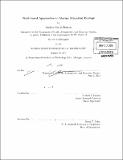| dc.contributor.advisor | Michael J. Follows. | en_US |
| dc.contributor.author | Barton, Andrew David | en_US |
| dc.contributor.other | Massachusetts Institute of Technology. Dept. of Earth, Atmospheric, and Planetary Sciences. | en_US |
| dc.date.accessioned | 2012-02-29T17:57:21Z | |
| dc.date.available | 2012-02-29T17:57:21Z | |
| dc.date.copyright | 2011 | en_US |
| dc.date.issued | 2011 | en_US |
| dc.identifier.uri | http://hdl.handle.net/1721.1/69465 | |
| dc.description | Thesis (Ph. D.)--Massachusetts Institute of Technology, Dept. of Earth, Atmospheric, and Planetary Sciences, 2011. | en_US |
| dc.description | Cataloged from PDF version of thesis. | en_US |
| dc.description | Includes bibliographical references. | en_US |
| dc.description.abstract | The goal of this thesis is to understand how the functional traits of species, biotic interactions, and the environment jointly regulate the community ecology of phytoplankton. In Chapter 2, I examined Continuous Plankton Recorder observations of diatom and dinoflagellate abundance in the North Atlantic Ocean and interpreted their community ecology in terms of functional traits, as inferred from laboratory- and field-based data. A spring-to-summer ecological succession from larger to smaller cell sizes and from photoautotrophic to mixotrophic and ieterotrophic phytoplankton was apparent. No relationship between maximum net growth rate and cell size or taxonomy was found, suggesting that growth and loss processes nearly balance across a range of cell sizes and between diatoms and dinoflagellates. In Chapter 3, I examined a global ocean circulation, biogeochemistry, and ecosystem model that indicated a decrease in) phytoplankton diversity with increasing latitude, consistent with observations of many marine and terrestrial taxa. Ii the modeled subpolar oceans, seasonal variability of the environment led to the competitive exclusion of phytoplankton with slower growth rates and to lower diversity. The relatively weak seasonality of the stable subtropical and tropical oceans in the global model enabled long exclusion timescales and prolonged coexistence of multiple phytoplankton with comparable fitness. Superimposed on this meridional diversity decrease were "hot spots" of enhanced diversity in soc regions of energetic ocean circulation which reflected a strong influence of lateral dispersal. In Chapter 4, I investigated how small-scale fluid turbulence affects phytoplankton nutrient uptake rates and community structure in an idealized resource competition model. The flux of nutrients to the cell and nutrient uptake are enhanced by turbulence, particularly for big cells in turbulent conditions. Yet with a linear loss form of grazing, turbulence played little role in regulating model community structure and the smallest cell size outcompeted all others because of its significantly lower R* (the minimum nutrient requirement at equilibrium). With a quadratic loss form of grazing, however, the coexistence of many phytoplankton sizes was possible and turbulence played a role in selecting the number of coexisting size classes and the dominant size class. The impact of turbulence on community structure in the ocean may be greatest in relatively nutrient-deplete regions that experience episodic inputs of turbulence kinetic energy. | en_US |
| dc.description.statementofresponsibility | by Andrew David Barton. | en_US |
| dc.format.extent | 118 p. | en_US |
| dc.language.iso | eng | en_US |
| dc.publisher | Massachusetts Institute of Technology | en_US |
| dc.rights | M.I.T. theses are protected by
copyright. They may be viewed from this source for any purpose, but
reproduction or distribution in any format is prohibited without written
permission. See provided URL for inquiries about permission. | en_US |
| dc.rights.uri | http://dspace.mit.edu/handle/1721.1/7582 | en_US |
| dc.subject | Earth, Atmospheric, and Planetary Sciences. | en_US |
| dc.title | Trait-based approaches to marine microbial ecology | en_US |
| dc.type | Thesis | en_US |
| dc.description.degree | Ph.D. | en_US |
| dc.contributor.department | Massachusetts Institute of Technology. Department of Earth, Atmospheric, and Planetary Sciences | |
| dc.identifier.oclc | 775342701 | en_US |
